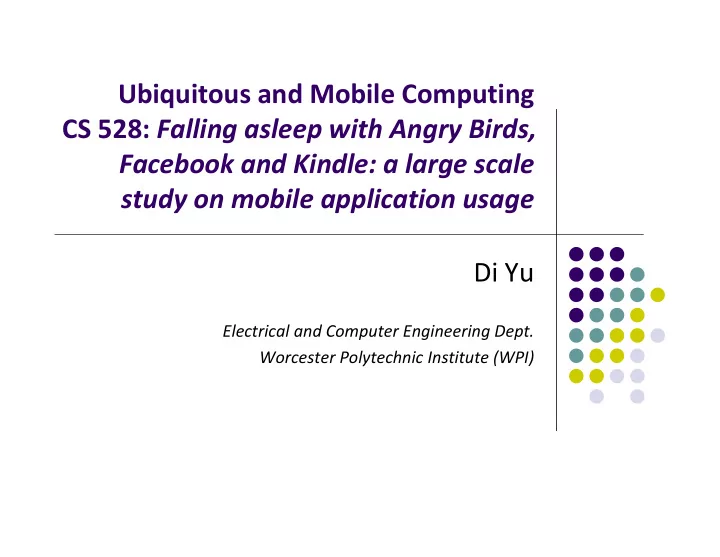

Ubiquitous and Mobile Computing CS 528: Falling asleep with Angry Birds, Facebook and Kindle: a large scale study on mobile application usage Di Yu Electrical and Computer Engineering Dept. Worcester Polytechnic Institute (WPI)
What's the problem ? Little public information exists on mobile application usage behavior: How long does each interaction with an app last? Does this vary be applcation category? How does the user's context (location and time) affect her app choices? What type of app is opened first? ... ...
Related Works Framework which is capable of tracking the high ‐ level functionality => limited in number of users, lenthg of study, and number of apps Using app store to gather feedback to improve an app => is limited to single application AppAware, which aggregating world ‐ wide occurrences of app installation => only focus on installation, update and deinstallation
Solution: AppSensor an approach of large ‐ scale, in ‐ the ‐ wild user studies with the fine ‐ grained measuring of app usage.
Lifecycle of a Mobile App
AppSensor features focus on two app states being used not being used based on Android platform Android os can report the most recently started application as part of appazaar application, runs background
Formal Description of AppSensor : set of apps that are available {a ,..., a } A 1 n : user is currently not using an app if app is used a a i i as ) ( t if no app is used => the user is running the same app as ( t ) as ( t ) 1 2 the user changes an app as ( t ) as ( t ) 1 2
Characteristcs of Final Dataset 4,125 users, between 08/16/2010 to 01/25/2011
average usage time of every categories's apps
Descriptive Statistics
Application Usage over Time hourly relative app usage by category in terms of launches
Chains of App Usage
Chains of App Usage
Chains of App Usage transition probabilities in app chains, from categories in a row to categories in a column
Application Usage by Location When In an airport ... Users were 2.78 times more likely to be using a browser. Users were less likely to be using games, tool applications. During flight, users were more than 2.26 more likely to be using an app of Multimedia. Less likely(0.83) to be using apps about Travel.
Specific Application Usage Top apps usage within a day based on hours
General Conclusion Users spend more than an hour a day using apps while spend less than 72 seconds with an app at a time. Mobile phones are still used mostly for communication. Some apps have spikes while others are broadly employed throughout the day. When actively using devices, users spend less time on a single app. People are less likely to use travel apps when travalling.
Vision: Making use of the AppSensor For inferring a user's context based on his actually used apps. Using the 'chains of app usage' to determine the users's current activity. Push useful informations based on the user's app usage history.
Limitations and tradeoff Some apps have a general purpose (browser) not capable of tracking multitasking currently dataset maynot represent a general population Higher sampling rates results in both higher accuracy and higher power consumption
References Adomavicius, G., and Tuzhilin, A. Context ‐ Aware recommender systems. In Recommender Systems Handbook, F. Ricci, L. Rokach, B. Shapira, and P. B. Kantor, Eds. Springer US, Boston, MA, 2011, ch. 7, 217– 253. AppsFire.com. Infographic: iOS Apps vs. Web Apps. http://blog.appsfire.com/infographic ‐ ios ‐ apps ‐ vs ‐ web ‐ apps,accessed on Feb. 15, 2010. Barkhuus, L., and Polichar, V. Empowerment through seamfulness: smart phones in everyday life. Personal and Ubiquitous Computing (Dec. 2010), 1–11. Bohmer, M., Bauer, G., and Kr ¨ uger, A. Exploring the ¨Design Space of Recommender Systems that Suggest Mobile Apps. In Proc. of Workshop CARS ’10 (2010). Church, K., and Smyth, B. Understanding mobile information needs. In Proceedings of the 10th international conference on Human computer interaction with mobile devices and services, MobileHCI ’08, ACM (New York, NY, USA, 2008), 493–494. Cui, Y., and Roto, V. How people use the web on mobile devices. In Proceeding of the 17th international conference on World Wide Web, WWW ’08, ACM (New York, NY, USA, 2008), 905–914. Demumieux, R., and Losquin, P. Gather customer’s real usage on mobile phones. In Proceedings of the 7th international conference on Human computer interaction with mobile devices and services, MobileHCI ’05, ACM (New York, NY, USA, 2005), 267–270.
Questions
Recommend
More recommend